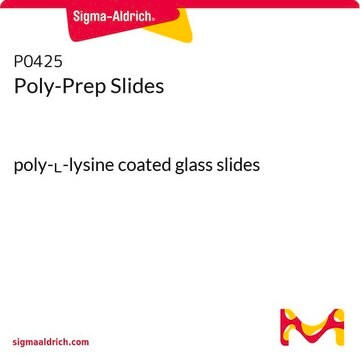P4832
Poly-ʟ-Lysine Hydrobromide
synthetic, mol wt 150,000-300,000, solution, 0.01%, suitable for cell culture
Synonim(y):
PLL Solution
About This Item
Polecane produkty
product name
Poly-L-lysine solution, mol wt 150,000-300,000, 0.01%, sterile-filtered, BioReagent, suitable for cell culture
sterylność
sterile-filtered
linia produktu
BioReagent
Postać
solution
masa cząsteczkowa
150,000-300,000
opakowanie
pkg of 50 mL
stężenie
0.01%
metody
cell culture | mammalian: suitable
zanieczyszczenia
endotoxin, tested
rozpuszczalność
water: soluble
Warunki transportu
ambient
temp. przechowywania
2-8°C
InChI
1S/C18H38N6O4/c19-10-4-1-7-13(22)16(25)23-14(8-2-5-11-20)17(26)24-15(18(27)28)9-3-6-12-21/h13-15H,1-12,19-22H2,(H,23,25)(H,24,26)(H,27,28)/t13-,14-,15-/m0/s1
Klucz InChI
WBSCNDJQPKSPII-KKUMJFAQSA-N
Szukasz podobnych produktów? Odwiedź Przewodnik dotyczący porównywania produktów
Powiązane kategorie
Opis ogólny
Zastosowanie
- In coating 96-well plates for cell attachment in testing respiratory burst activity.
- In coating glass cover slips for immunofluorescent labeling of intracellular structures.
- For pretreating 6-well plate in myosatellite cell isolation protocol.
- In coating coverslips for cell adhesion in E14 neuron culture to study possible mechanism of action of circRNA_01477 in neurons.
Działania biochem./fizjol.
Komponenty
Uwaga dotycząca przygotowania
produkt podobny
produkt powiązany
Kod klasy składowania
12 - Non Combustible Liquids
Klasa zagrożenia wodnego (WGK)
WGK 2
Temperatura zapłonu (°F)
Not applicable
Temperatura zapłonu (°C)
Not applicable
Certyfikaty analizy (CoA)
Poszukaj Certyfikaty analizy (CoA), wpisując numer partii/serii produktów. Numery serii i partii można znaleźć na etykiecie produktu po słowach „seria” lub „partia”.
Masz już ten produkt?
Dokumenty związane z niedawno zakupionymi produktami zostały zamieszczone w Bibliotece dokumentów.
Klienci oglądali również te produkty
Produkty
Poly-Lysine enhances cell binding with positively-charged surface ions, optimizing electrostatic interaction on culture surfaces for increased cell attachment.
Poli-lizyna zwiększa wiązanie komórek z dodatnio naładowanymi jonami powierzchniowymi, optymalizując interakcje elektrostatyczne na powierzchniach hodowli w celu zwiększenia przyczepności komórek.
3D cell culture overview. Learn about 2D vs 3D cell culture, advantages of 3D cell culture, and techniques available to develop 3D cell models
Przegląd hodowli komórek 3D. Dowiedz się więcej o hodowli komórek 2D i 3D, zaletach hodowli komórek 3D i technikach dostępnych do tworzenia modeli komórek 3D
Protokoły
Adhere cells to solid substrates using poly-lysine, which enhances electrostatic interaction between negatively charged ions of the cell membrane and the culture surface.
Przyleganie komórek do stałych podłoży za pomocą poli-lizyny, która wzmacnia elektrostatyczne oddziaływanie między ujemnie naładowanymi jonami błony komórkowej a powierzchnią hodowli.
Nasz zespół naukowców ma doświadczenie we wszystkich obszarach badań, w tym w naukach przyrodniczych, materiałoznawstwie, syntezie chemicznej, chromatografii, analityce i wielu innych dziedzinach.
Skontaktuj się z zespołem ds. pomocy technicznej







